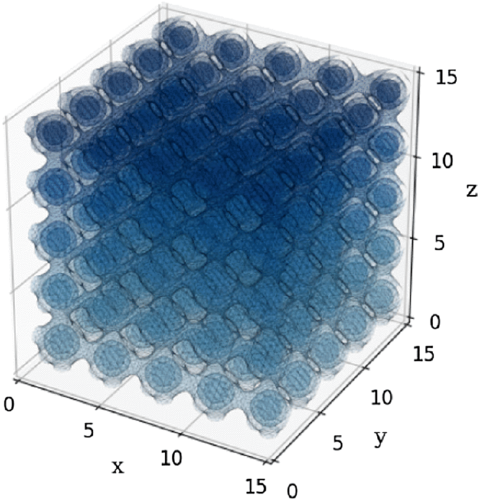Astronomy Object of the Month: 2019, May
< previous Archive next >
New method of constructing inhomogeneous cosmological models
Studies of inhomogeneous cosmological models are an actively developed branch of
general relativity and cosmology. By developing new techniques for solving the physically motivated issues of Einstein's theory of gravity, we
expand our knowledge of the Universe with unknown phenomena and set future directions for research.

Illustration 1: Isodensity surfaces in the considered model create an infinite, periodic network of overdensities and underdensities. Credit: the Authors.
Contemporary cosmology is based on a standard cosmological model in which a homogeneous and isotropic space is filled with matter described by a perfect fluid. Despite its simplicity, this model is suitable for describing the global evolution of the Universe and for analyzing astronomical observations. The main disadvantage, however, is the lack of cosmological structures, clusters of galaxies, filaments and voids, which is associated with uncertainty as to the interpretation of observational results.
Inhomogeneous cosmological models form a class of solutions of the relativity equations that they contain and are created by the inhomogeneities of matter and geometry with potentially arbitrarily high contrast. They allow us to follow the evolution of structures, and to study the effects caused by the viscosity of matter that were important in the early Universe. Their main advantage is the ability to analyze the impact of structures on light propagation, which is extremely important for correct interpretation of current observations. In addition, inhomogeneous models are used in the study of the averaging problem in cosmology, in which we ask if and how one can describe the dynamics of non-homogeneous space-time through an effective homogeneous space-time.
However, very few solutions have been found so far, and the few known ones usually have undesirable symmetries. That is why it is so important to look for new inhomogeneous models with physically interesting properties.
In this work, the construction of the cosmological model containing the periodic distribution of dust inhomogeneities is presented. This construction is perturbative, however, unlike other such approaches, thanks to the strict control of high-order perturbation equations, a model with high density contrast was obtained. In spite of the complexity of the problem, the adopted construction strategy allowed to keep its metric in a relatively simple form. The dynamics of this model significantly differentiate it from the homogeneous model, so that it can not be approximated by the evolution of perturbations on a fixed background. The light propagation analysis carried out in the obtained model showed that its distance function significantly differs from the distance function of the averaged model and strongly depends on the observer's position in relation to inhomogeneities.
The results of the work indicate that for the proper assessment of the results of cosmological astronomical observations it is necessary to consider the presence of structures in the Universe. First of all, it concerns local structures, close to the observer. The construction scheme presented in the work turned out to be feasible and the obtained model could be subjected to effective analysis. The general nature of the newly presented approach will allow it to be further extended in the future and will enable research into even more realistic cosmological models.
Original publication: Perturbatively constructed cosmological model with periodically distributed dust inhomogeneities; Szymon Sikora, Krzysztof Głód, Physical Review D, 99, 083521 (2019).
The research was conducted at the Department of Relativistic Astrophysics and Cosmology of the Jagiellonian University’s Astronomical Observatory (OAUJ).
|
Krzysztof Głód Astronomical Observatory Jagiellonian University K.Glod [at] uj.edu.pl |


